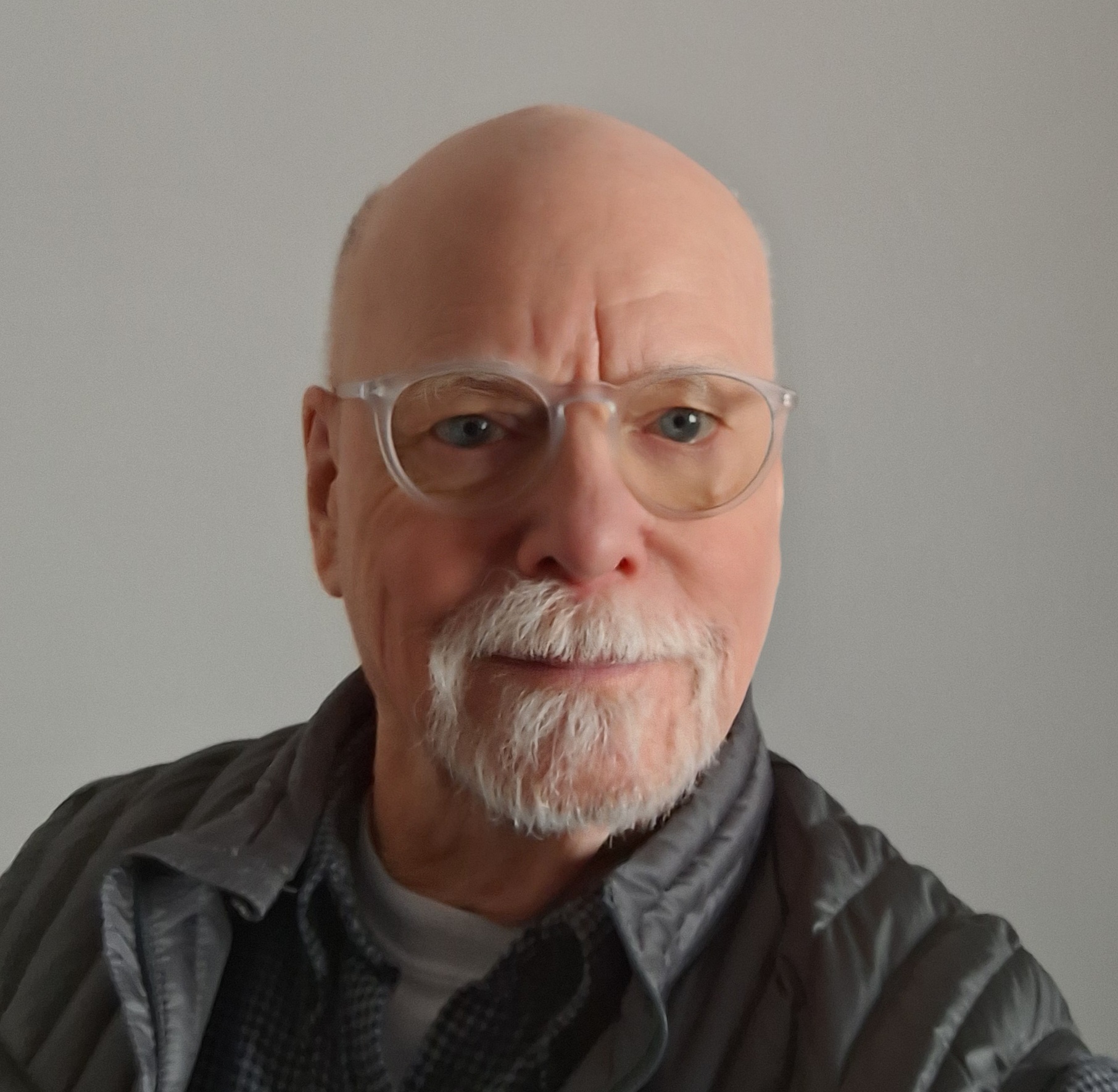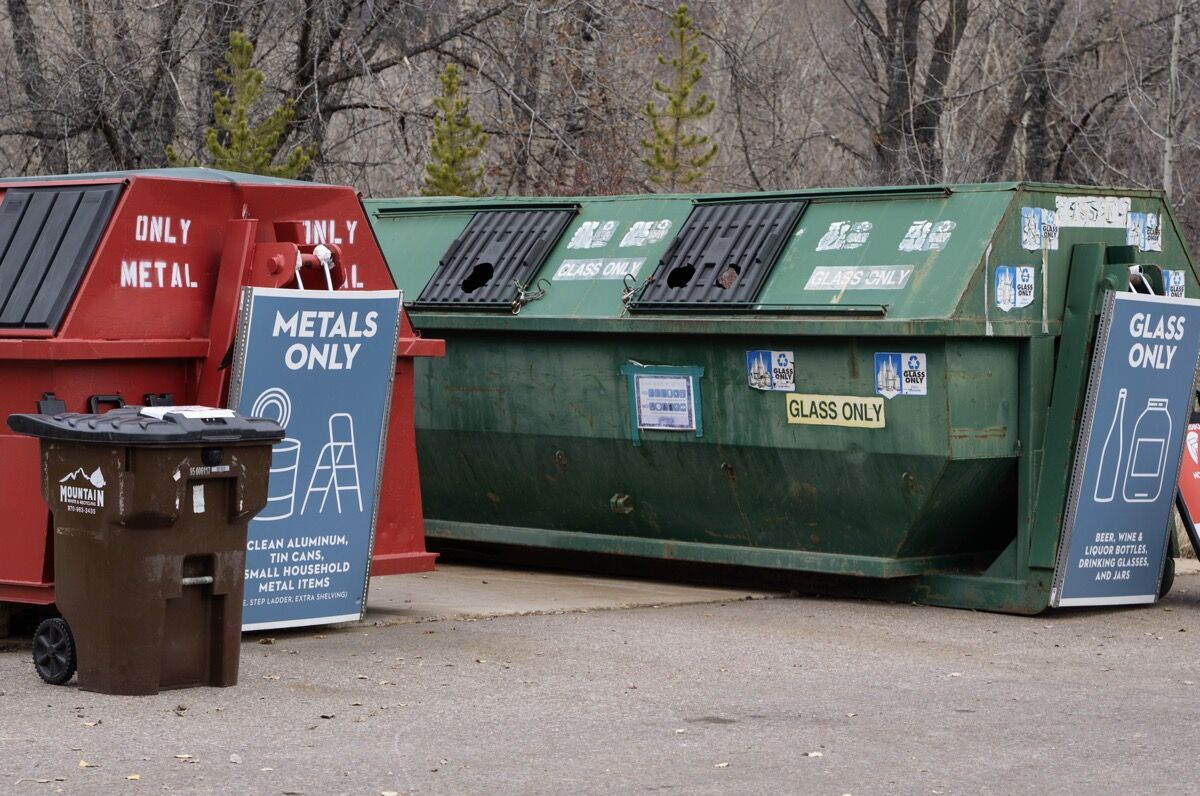As a shy and bearded young architecture student at the University of Southern California in the spring of 1970, Gary Anderson happened upon a flyer advertising a graphic-design contest. It called for students to create a symbol to promote the recycling of paper products, with a winner to be selected at that summer’s International Design Conference at Aspen.
The winning black-ink icon that Anderson created featured a series of folded arrows chasing one another in a triangle. It would become one of the most recognizable icons in the world.
“I had an idea of what I wanted to do and worked on it for a day or two,” recalled Anderson, now 76, who is returning to Aspen for the first time to discuss his symbol and its complicated legacy. The event, at the Pitkin County Library on March 18, will be hosted by the Aspen Institute’s Resnick Center for Herbert Bayer Studies (Bayer Center).
The idea
Anderson was an architecture student, but the contest specs seemed simple enough for the 22-year-old to handle on his own at a drafting desk: It called for a black-and-white design that could be reduced to 2 inches and stamped on products. And its ethos was in line with his budding environmental concerns, informed by youth movements on campus, the phenomenon of Rachel Carson’s “Silent Spring,” the advent of the first Earth Day and the national green push that would soon lead to the creation of the Environmental Protection Agency.
The national contest, which drew more than 500 submissions from high school and college students, was sponsored by the Container Corp. of America, the Paepcke family business based in Chicago, profits from which had funded the birth of modern Aspen in the 1940s as a ski resort and would-be utopia and backed institutions such as the Aspen Music Festival, Aspen Institute and International Design Conference at Aspen.
“We asked them, ‘for the love of Earth,’ to design a symbol that would remind concerned citizens that recycling or reuse of materials extends the life of our natural resources — a symbol that could be placed upon packages we make from recyclable or recycled fibers, to promote public awareness that recycling provides an opportunity to improve environmental quality,” read a September 1970 Container Corp. of America announcement detailing Anderson’s win and the company’s plans for the symbol.
Under the leadership of Walter Paepcke, the Container Corp. of America had spearheaded recycling efforts decades earlier. By the mid-1940s, most of the company’s cardboard boxes were made with recycled paper material. Paepcke had also promoted recycling with innovative modernist advertising campaigns during World War II, in ads designed by Bauhaus artist and Aspen resident Herbert Bayer.
Paepcke and Bayer in the postwar years launched initiatives at Container Corp. of America comprising what today would be called a corporate sustainability mission, promoting Earth-friendly public policy, conservation, sustainable and equitable distribution of natural resources. The Container Corp. of America claimed to be the largest user of recycled paper in the United States in 1970, collecting more than 1 million tons of waste paper — or 10% of the industry total at the time — to make recycled products.
Paepcke died in 1960, but the company’s environmental mission and its inextricable ties to Aspen remained.
The recycling symbol contest was judged by an eight-person panel of leading designers including Bayer and giants such as film industry innovator Saul Bass and IBM design director Eliot Noyes, who was also chair of the design conference. The contest winner would receive a $2,500 tuition grant and a trip to the conference.
Anderson drew on personal and artistic influences for his symbol. He knew he wanted to include a triangle with Mobius strip-inspired folding corners and arrows connecting its segments. As a schoolboy, he had gone on a field trip to a newspaper printing press and watched reams of paper running through rollers — he wanted to capture that movement in his symbol, which led him to incorporate the arrows. He made several versions, each iteration growing simpler than the last. He submitted three versions for the contest. The one with the least ornamentation, inked in black over his pencil sketches, and instantly recognizable today, was selected by Bayer and the panel as the winner.

Anderson wasn’t acquainted with the history of the conference, Paepcke or Bayer at the time.
“I just submitted my design, I got the award, and that was it,” Anderson recalled. “Over the years, I’ve come to know more about Herbert Bayer and the graphic designers who were on jury.”
The Container Corp. of America placed the symbol in the public domain in the hopes that it would be used widely to mark products made from recycled and recyclable paper products, making the symbol available in the fall of 1970 to all industries that recycle their products.
“Many government officials, industry leaders, conservationists and ecologists believe that recycling is the ultimate answer to solid-waste problems,” reads the Container Corp. of America announcement. “Display of the new symbol on packages and other items of recycled and recyclable fibers should spread awareness among concerned citizens that waste paper recycling is an important and effective method of conservation.”
The young Anderson drove his Volkswaagen camper to Aspen for the design conference, which by then had been running annually in Aspen since 1951 and was well established as a premier global convening of designers, artists and architects.
“It was consciousness-expanding to be among all of those designers and just listening to what some of them had to say about the issues of design in the world at that time,” Anderson recalled.
The 1970 conference, whose theme was “Environment By Design,” attempted to harness the interest and intensity of the burgeoning environmental movement in its proceedings and in the recycle symbol contest. But it hosted clashes pitting design students and activists against the design establishment. Although the recycle-symbol contest judging took place at the 1970 conference, Anderson is unsure whether his attendance was that year or the following, after the symbol was in use.
The contest itself was an overt attempt by Container Corp. of America and the conference to provide a platform to the ascendant baby boomers. As they put it in the announcement: “We could have designed this symbol ourselves, but we felt that the younger generation, as inheritors of the earth, should have their say.”
Design historian Alice Twemlow, in a detailed account of the culture clashes at the 1970 conference collected in the book “Aspen Complex,” wrote that it “provided the setting for an ideological collision between members of the American liberal design establishment who organized the conference and an assortment of environmentalists, design and architecture students, and a French delegation from the context of the Utopie group, who were all frustrated with what they saw as the conference’s lack of political engagement. Aspen 1970 also provided the setting for a critique of the formats, modes of address and registers through which design discourse was advanced.”
Anderson recalled one memorable session where a young participant, knitting and talking at once in a seminar discussion, excoriated older designers for being tools of capitalism.
‘Separate ways’
Anderson used his prize money to study abroad in Sweden and begin work on his graduate studies in architecture. His symbol was not widely adopted initially. Anderson recalled that the first time he saw the symbol in public was years later, when he spotted it on recycling bins in Amsterdam in the late 1970s.
But as residential and commercial recycling efforts boomed in the 1980s and 1990s, the symbol became ubiquitous.
Anderson went on to a career in urban planning and architecture, never pursuing graphic design and thinking little of his recycling symbol. The creator of one of the world’s most recognizable designs, in fact, didn’t even put it on his resume.

“The symbol and I went our separate ways for a while,” Anderson said. “Even after it became a widely recognized symbol, I played it down because my career, as far as I was concerned, was in architecture and planning. On my resume, I didn’t even mention it because I didn’t want it to detract from my accomplishments in architecture.”
Although the contest win in 1970 shined a brief spotlight on Anderson, he fell into design anonymity thereafter. His work in architecture and planning won him awards and took him to professional posts in California, Europe, Saudi Arabia and Maryland, where he is now retired. His authorship of the recycle symbol, as it became adopted around the globe in the decades that followed, was anonymous.
That changed in the late 1990s when a recycling education specialist in Morris County, New Jersey, named Penny Jones took on the project of celebrating the symbol’s creator. She identified Anderson, found him in Maryland and told his story in the May 1999 trade publication Resource Recycling. (Underscoring the symbol creator’s mythical status among recycling gurus, the article, written with journalist Jerry Powell, was headlined triumphantly: “Gary Anderson Has Been Found!”)
“It was only after that that people started to get in touch with me,” Anderson said.
He has embraced his place in design history since then, discussing his recycle symbol when asked. He never dabbled in graphic design again, though.
“I’m a one-hit wonder when it comes to graphics,” he said.

Controversy and confusion
The wider adoption of the recycle symbol bred unanticipated confusion.
In 1988, the plastics industry began placing similar-looking trademarked symbols on products, using an arrowed triangle for the plastic “resin code,” developed by the industry trade group Society of Plastics Institute, which uses numbers inside of an Anderson-styled triangle to indicate an item’s chemical makeup and recyclability.
Although Anderson’s symbol had been created to signify that something was recyclable or was made of recycled material, products with a resin code often aren’t made from recycled products and may or may not be recyclable depending on where a consumer is attempting to dispose of them.
“People see the symbol and think they can recycle it, and that’s not the case,” said Liz Chapman, executive director of the nonprofit Recycle Colorado, who will join Anderson on the panel in Aspen.
When Chapman gives talks on recycling issues, she frequently begins her addresses by telling the story of Anderson’s symbol.
“I explain that there was an artist that created something for everyone to use, and then there were business people that capitalized on that and trademarked it and confused the whole system, and we are still struggling to overcome that barrier,” she said.
In Finis Dunaway’s book “Seeing Green: The Use and Abuse of American Environmental Images” (2015), he argues that the recycle symbol is one of many images co-opted by industry and polluters in order to preserve the status quo and delay systemic change.
“Deflecting attention from corporate and government responsibility, popular images have instead emphasized the idea that individual Americans are personally culpable for pollution and other environmental problems,” Dunaway wrote.
The Federal Trade Commission is in the process of revising its “Green Guides,” which regulate advertising and product-labeling claims regarding environmental efforts. It could create more stringent standards for products using the recycling symbol. In April, the EPA called on the FTC to stop allowing use of the symbol on plastics in order to cut down on the confusion and keep nonrecyclables out of recycling facilities.
Anderson is quick to note that he is not an expert on recycling, but he believes the confusion surrounding the symbol was avoidable.
“I think federal regulators could have stepped in long ago to help sort these things out and guide the overall recycling process,” he said.
Recycle Colorado hasn’t taken a position, but Chapman believes stricter rules could help reduce waste.
“I personally think that having some federal oversight to control the use of that symbol could only be helpful to reduce confusion and start to clarify what they mean,” she said.
Chapman points to the high rate of paper recycling as reason for optimism. (The American Forest & Paper Association reported in 2022 that more than 67% of paper used in the U.S. is recycled.) She argues that such success is, in part, due to companies’ giving consumers clear choices and promoting recycled paper. Low plastic-recycling rates, she argues, result from the cost and complexity of plastics recycling, as well as consumer confusion.
Plastic beverage and consumer products containers are recycled at a 21% rate in the U.S., according to a Recycling Partnership report, although overall plastic recycling is far lower. (A highly publicized 2022 Greenpeace report found that number is less than 6%.) Colorado is among the worst-performing states for recycling, capturing 14% of recyclable material, according to the Recycling Partnership.
Chapman chalks that up to the state’s decentralized population and the fact that in much of rural Colorado, the recycling rate is zero. Aspen and Pitkin County, birthplace of the recycle symbol, are consistently among the highest-performing recycling communities in the state, with robust recycling programs in place bolstered by local laws that require trash haulers to offer recycling service and barring them from charging extra for it. Pitkin County’s rate, according to a 2023 EcoCycle report, was 48%.
Andrew Travers is an Aspen-based freelance journalist and Penner Manager of Educational Programs at the Aspen Institute. He will moderate a discussion with Gary Anderson and Liz Chapman at the Dunaway Room in the Pitkin County Library on March 18 from 6 to 7 p.m. The event is free; registration is required, learn more online at eventbrite.com, searching for “The Recycling Symbol: Born in Aspen.”

